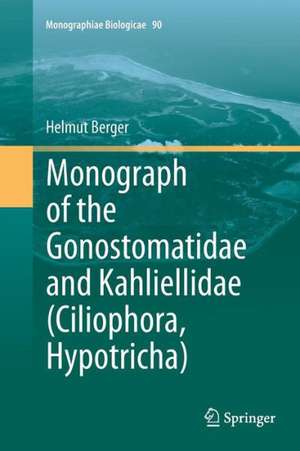Monograph of the Gonostomatidae and Kahliellidae (Ciliophora, Hypotricha): Monographiae Biologicae, cartea 90
Autor Helmut Bergeren Limba Engleză Paperback – 25 feb 2013
Gonostomum was previously misclassified in the Oxytrichidae because its type species Gonostomum affine has basically an 18-cirri pattern, which is dominant in the oxytrichids. A new hypothesis, considering also molecular data, postulates that this 18-cirri pattern evolved in the last common ancestor of the hypotrichs and therefore it appears throughout the Hypotricha tree. The simple dorsal kinety pattern, composed of only three bipolar dorsal kineties, and gene sequence analyses strongly suggest that Gonostomum branches off rather early in the phylogenetic tree. Thus, the Gonostomatidae, previously synonymised with the oxytrichids, are reactivated to include the name-bearing type genus and other genera (e.g., Paragonostomum, Wallackia, Cladotricha) which have the characteristic gonostomatid oral apparatus. The Kahliellidae are a rather vague group mainly defined via the preservation of parts of the parental infraciliature. The kahliellids preliminary comprise, besides the name-bearing type genus Kahliella, genera such as Parakahliella and its African pendant Afrokahliella or the monotypic Engelmanniella. In total 68 species distributed in 21 genera and subgenera are revised. As in the previous volumes almost all morphological, morphogenetic, molecular, faunistic, and ecological data, scattered in almost 700 papers, are compiled so that the four volumes (Oxytrichidae, Urostyloidea, Amphisiellidae and Trachelostylidae, Gonostomatidae and Kahliellida) provide a detailed insight into the biology of almost 500 species of hypotrichs. The series is an up-to-dateoverview about this highly interesting taxon of spirotrichous ciliates mainly addressed to taxonomists, cell biologists, ecologists, molecular biologists, and practitioners.
| Toate formatele și edițiile | Preț | Express |
|---|---|---|
| Paperback (1) | 1837.45 lei 6-8 săpt. | |
| SPRINGER NETHERLANDS – 25 feb 2013 | 1837.45 lei 6-8 săpt. | |
| Hardback (1) | 1843.91 lei 6-8 săpt. | |
| SPRINGER NETHERLANDS – 11 ian 2011 | 1843.91 lei 6-8 săpt. |
Din seria Monographiae Biologicae
- 24%
 Preț: 2612.51 lei
Preț: 2612.51 lei - 18%
 Preț: 948.92 lei
Preț: 948.92 lei - 15%
 Preț: 648.74 lei
Preț: 648.74 lei -
 Preț: 397.59 lei
Preț: 397.59 lei - 28%
 Preț: 91.90 lei
Preț: 91.90 lei -
 Preț: 379.86 lei
Preț: 379.86 lei -
 Preț: 388.34 lei
Preț: 388.34 lei -
 Preț: 414.91 lei
Preț: 414.91 lei -
 Preț: 395.47 lei
Preț: 395.47 lei -
 Preț: 389.49 lei
Preț: 389.49 lei -
 Preț: 401.24 lei
Preț: 401.24 lei -
 Preț: 394.71 lei
Preț: 394.71 lei -
 Preț: 405.99 lei
Preț: 405.99 lei -
 Preț: 425.84 lei
Preț: 425.84 lei -
 Preț: 381.21 lei
Preț: 381.21 lei -
 Preț: 389.56 lei
Preț: 389.56 lei - 18%
 Preț: 1833.65 lei
Preț: 1833.65 lei - 18%
 Preț: 1230.35 lei
Preț: 1230.35 lei - 18%
 Preț: 1027.08 lei
Preț: 1027.08 lei -
 Preț: 399.67 lei
Preț: 399.67 lei - 18%
 Preț: 2493.72 lei
Preț: 2493.72 lei -
 Preț: 417.59 lei
Preț: 417.59 lei -
 Preț: 404.89 lei
Preț: 404.89 lei - 20%
 Preț: 557.46 lei
Preț: 557.46 lei -
 Preț: 418.76 lei
Preț: 418.76 lei -
 Preț: 408.37 lei
Preț: 408.37 lei - 15%
 Preț: 650.69 lei
Preț: 650.69 lei - 15%
 Preț: 652.31 lei
Preț: 652.31 lei -
 Preț: 395.37 lei
Preț: 395.37 lei - 18%
 Preț: 1232.26 lei
Preț: 1232.26 lei - 15%
 Preț: 637.59 lei
Preț: 637.59 lei - 18%
 Preț: 1231.95 lei
Preț: 1231.95 lei - 18%
 Preț: 1226.90 lei
Preț: 1226.90 lei - 15%
 Preț: 658.22 lei
Preț: 658.22 lei -
 Preț: 353.75 lei
Preț: 353.75 lei - 18%
 Preț: 1224.36 lei
Preț: 1224.36 lei -
 Preț: 386.22 lei
Preț: 386.22 lei - 20%
 Preț: 723.22 lei
Preț: 723.22 lei - 15%
 Preț: 652.49 lei
Preț: 652.49 lei - 18%
 Preț: 1228.62 lei
Preț: 1228.62 lei - 18%
 Preț: 945.30 lei
Preț: 945.30 lei - 18%
 Preț: 1231.64 lei
Preț: 1231.64 lei - 15%
 Preț: 633.68 lei
Preț: 633.68 lei - 20%
 Preț: 572.09 lei
Preț: 572.09 lei - 18%
 Preț: 1844.54 lei
Preț: 1844.54 lei -
 Preț: 386.61 lei
Preț: 386.61 lei
Preț: 1837.45 lei
Preț vechi: 2240.78 lei
-18% Nou
Puncte Express: 2756
Preț estimativ în valută:
351.64€ • 365.76$ • 290.30£
351.64€ • 365.76$ • 290.30£
Carte tipărită la comandă
Livrare economică 14-28 aprilie
Preluare comenzi: 021 569.72.76
Specificații
ISBN-13: 9789400734920
ISBN-10: 9400734921
Pagini: 756
Ilustrații: XIV, 742 p.
Dimensiuni: 155 x 235 x 40 mm
Greutate: 1.04 kg
Ediția:2011
Editura: SPRINGER NETHERLANDS
Colecția Springer
Seria Monographiae Biologicae
Locul publicării:Dordrecht, Netherlands
ISBN-10: 9400734921
Pagini: 756
Ilustrații: XIV, 742 p.
Dimensiuni: 155 x 235 x 40 mm
Greutate: 1.04 kg
Ediția:2011
Editura: SPRINGER NETHERLANDS
Colecția Springer
Seria Monographiae Biologicae
Locul publicării:Dordrecht, Netherlands
Public țintă
ResearchCuprins
A General Section.- B Systematic Section.- Gonostomatidae (33 species).- Kahliellidae (15 species).- Taxa of Unknown Position in the Non-dorsomarginalian Hypotricha (14 species).- Supplement to Apourosomoida (5 species).- References.- Systematic Index.- Table Index.
Textul de pe ultima copertă
The present monograph is the fourth of six volumes which review the Hypotricha, a major group of the spirotrichs. The book is about the Gonostomatidae, the Kahliellidae, and some taxa of unknown position in the hypotrichs.
Gonostomum was previously misclassified in the Oxytrichidae because its type species Gonostomum affine has basically an 18-cirri pattern, which is dominant in the oxytrichids. A new hypothesis, considering also molecular data, postulates that this 18-cirri pattern evolved in the last common ancestor of the hypotrichs and therefore it appears throughout the Hypotricha tree. The simple dorsal kinety pattern, composed of only three bipolar dorsal kineties, and gene sequence analyses strongly suggest that Gonostomum branches off rather early in the phylogenetic tree. Thus, the Gonostomatidae, previously synonymised with the oxytrichids, are reactivated to include the name-bearing type genus and other genera (e.g., Paragonostomum, Wallackia, Cladotricha) which have the characteristic gonostomatid oral apparatus. The Kahliellidae are a rather vague group mainly defined via the preservation of parts of the parental infraciliature. The kahliellids preliminary comprise, besides the name-bearing type genus Kahliella, genera such as Parakahliella and its African pendant Afrokahliella or the monotypic Engelmanniella. In total 68 species distributed in 21 genera and subgenera are revised. As in the previous volumes almost all morphological, morphogenetic, molecular, faunistic, and ecological data, scattered in almost 700 papers, are compiled so that the four volumes (Oxytrichidae, Urostyloidea, Amphisiellidae and Trachelostylidae, Gonostomatidae and Kahliellida) provide a detailed insight into the biology of almost 500 species of hypotrichs. The series is an up-to-dateoverview about this highly interesting taxon of spirotrichous ciliates mainly addressed to taxonomists, cell biologists, ecologists, molecular biologists, and practitioners.
Gonostomum was previously misclassified in the Oxytrichidae because its type species Gonostomum affine has basically an 18-cirri pattern, which is dominant in the oxytrichids. A new hypothesis, considering also molecular data, postulates that this 18-cirri pattern evolved in the last common ancestor of the hypotrichs and therefore it appears throughout the Hypotricha tree. The simple dorsal kinety pattern, composed of only three bipolar dorsal kineties, and gene sequence analyses strongly suggest that Gonostomum branches off rather early in the phylogenetic tree. Thus, the Gonostomatidae, previously synonymised with the oxytrichids, are reactivated to include the name-bearing type genus and other genera (e.g., Paragonostomum, Wallackia, Cladotricha) which have the characteristic gonostomatid oral apparatus. The Kahliellidae are a rather vague group mainly defined via the preservation of parts of the parental infraciliature. The kahliellids preliminary comprise, besides the name-bearing type genus Kahliella, genera such as Parakahliella and its African pendant Afrokahliella or the monotypic Engelmanniella. In total 68 species distributed in 21 genera and subgenera are revised. As in the previous volumes almost all morphological, morphogenetic, molecular, faunistic, and ecological data, scattered in almost 700 papers, are compiled so that the four volumes (Oxytrichidae, Urostyloidea, Amphisiellidae and Trachelostylidae, Gonostomatidae and Kahliellida) provide a detailed insight into the biology of almost 500 species of hypotrichs. The series is an up-to-dateoverview about this highly interesting taxon of spirotrichous ciliates mainly addressed to taxonomists, cell biologists, ecologists, molecular biologists, and practitioners.
Caracteristici
Summarises the morphology, fauna and ecology of the Gonostomatidae and Kahliellidae Including 68 species distributed in 21 genera and revised subgenera Featuring more than 270 figures Offers thorough up-to-date revision for taxonomists, cell biologists, and ecologists Includes supplementary material: sn.pub/extras














